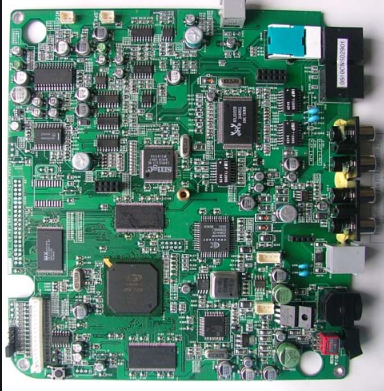The general structure when drilling the micro-holes of the printed circuit board: that is, the top layer is the cover plate, the middle is the PCB board, and the lower layer is the backing board. In the modern printed circuit board processing process, in order to ensure that the board has a higher drilling quality and drilling efficiency, the use and correct matching of the cover plate and the backing plate are particularly important. At present, the more commonly used cover plates in the industry include: a variety of aluminum sheets, composite aluminum cover plates, phenolic cover plates, epoxy glass cloth panels and cold punched plates, etc.; commonly used backing plates include: high-density wood backing boards, phenolic wood mats Board, melamine wood backing board, phenolic paper backing board, high-density fiberboard and aluminum foil composite wood backing board, etc.
When drilling the micro-holes of the printed circuit board, the backing plate used should meet the following requirements: It must have suitable surface hardness, which can reduce the burr of the hole surface and avoid the wear of the drill due to excessive hardness;

the composition does not contain resin to avoid Produce drilling dirt; It must have a large thermal conductivity to quickly conduct the drilling heat and reduce the drilling temperature; It must have sufficient elasticity to reduce the resistance when drilling, so that the drill can be accurately positioned, thereby improving the accuracy of the hole position, At the same time, it is necessary to ensure the rigidity to avoid the vibration of lifting the drill. Therefore, choosing the right cover is crucial to the drilling process.
At the same time, the role of the backing plate is also very important. In the PCB drilling process, the backing plate used is located under the plate to be processed to play the role of protecting the plate and the drilling machine, drilling through the plate and improving the quality of the micro-holes. In order to ensure the quality of hole processing, the backing plate should have good flatness and excellent dimensional tolerance, easy to cut, hard and flat surface, and the inner hole surface or drill bit should be drilled at high temperature. At the same time, the drilling should be fine and powdery, easy to arrange Crumbs.
In the process of micro-hole drilling of printed circuit boards, selecting suitable cover plates and various printed circuit boards for matching drilling can not only improve drilling quality and increase yield, but also extend drill life and reduce production costs. Therefore, the development of a new type of cover plate with superior performance, reasonable cost, and capable of meeting the needs of high-end PCB drilling has become an important research goal for cover plate manufacturers.
1. Current status of domestic and foreign development of covers and pads
The cover and backing plate for PCB drilling appear almost at the same time as the PCB board. During the drilling process, cover and backing plates must be added to the bottom and bottom of the PCB board to protect the PCB board and improve the accuracy of the hole position. At the beginning, the phenolic resin cover plate was used, which can meet the requirements of conventional drilling to a certain extent. Due to the easy occurrence of drilling pollution, epoxy fiberglass board was once used in the PCB industry, but it could not completely solve the problem of drilling pollution, so it could not meet the production requirements, and the cost of epoxy glass fiber board was also High, so the history of its use is not very long, so it was abandoned.
In the early 1990s, wood fiberboard began to be used as a drilling pad due to its low price, high stability, less drilling pollution and relatively good heat resistance. In the mid to late 1990s, the selection of cover plates used in PCB drilling processing also began to adopt another type of better thermal conductivity, namely metal cover plates. At first, ordinary soft aluminum was used. The thermal conductivity of aluminum is much higher than that of resin. The maximum temperature of the drill bit can be reduced from 2 000 degree Celsius to more than 1 000 degree Celsius. Abnormalities such as poor hole position accuracy and broken needles. As a result, a substitute aluminum alloy cover plate with better processing performance came out, and it has become one of the cover plate varieties that are still commonly used. At the beginning of the 21st century, with the gradual reduction of the hole diameter (below 0.3mm) and the continuous improvement of the quality of the drilling, the manufacturers of the cover and backing board began to develop and improve the original phenolic resin paper backing board products, and their material characteristics, Density, surface hardness, flatness, thickness uniformity, material, etc. have all been improved. At the same time, in order to solve the problem that the surface of the alloy aluminum cover plate is too hard and easily causes slippage, a lubricating aluminum sheet has been developed.
According to the different material composition, the industry often divides the cover into four categories: lubricating aluminum sheet, ordinary aluminum sheet, phenolic paper cover and epoxy glass cloth cover. Backing boards are mainly divided into three categories: wood backing boards, wood fiber boards and phenolic paper backing boards. At present, the main domestic use of cover plates is aluminum sheet, which accounts for about 82.2%; the main use of backing plates is wood pulp board, which accounts for about 59.1%.
With the development of high-end, functional and special PCB technology, the cover plate, as an auxiliary material for printed circuit board drilling, is also developing towards refinement, diversification and functionalization. The type and quality of the cover plate play a vital role in the hole quality of the printed circuit board drilling, processing efficiency, yield, drill bit life and the final reliability of the printed circuit board.